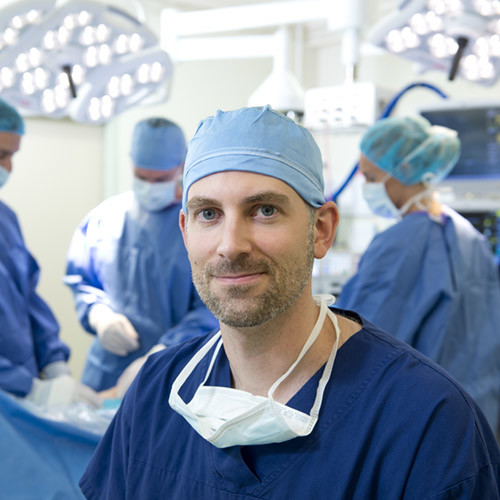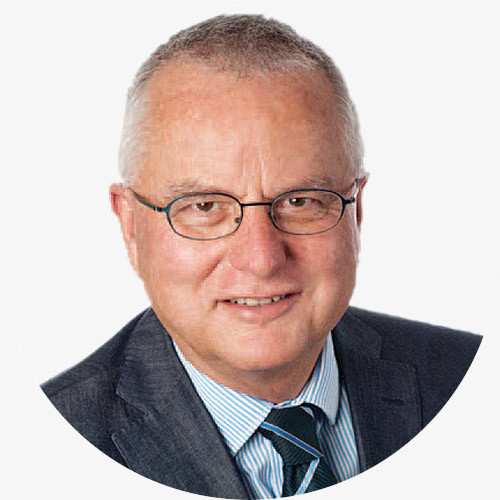
Total Hip Replacement (THR)
Total Hip Replacement is the surgery performed to replace a damaged or worn hip joint.
A smooth and compressible substance known as articular cartilage coats the surface of the ball (femoral head) and socket (acetabulum). Arthritis occurs when the articular cartilage wears away exposing the underlying bone. This causes roughening and distortion of the joint, resulting in painful and restricted movement. A limp will often develop and the leg may become weak and shortened.
The new joint relieves pain, improves walking ability, decreases stiffness and in most cases restores leg length and may correct the limp.
Osteoarthritis of the hip is generally a disease of the older person but may occur in younger people following rheumatoid arthritis, fractures of the hip and other rarer conditions.
There are many different types available, but all consist of the same basic components – one component replaces the worn socket and is called the acetabular cup and the other replaces the worn head of the femur and consists of a metal or ceramic ball mounted on a stem. Some hip replacements are fixed in place using special bone cement. Others have a rough, porous surface into which bone grows to lock the implant in place. Each type has advantages and disadvantages. Occasionally your surgeon may recommend other materials.
- Infection – (1%) Fortunately, with good surgical technique and the use of antibiotics this is a rare complication but if it does occur it is serious and may result in the need to remove the artificial joint components.
- Blood clots – after joint replacement surgery are common. The risk is reduced by giving blood-thinning medication that starts the night after surgery. These clots can rarely break off and go to the lungs leading to severe breathing problems or even death.
- Dislocation – (1%) usually occurs in the first weeks or months. May be caused by crossing legs, twisting on leg or sitting in low chair. May require anaesthetic to “put the hip back” and rarely requires further surgery. i.e. removal and replacement with a new artificial one.
- Loosening – is the major long-term problem but usually is not significant for 10-15 years. Occasionally the hip may loosen earlier than this and may require revision, i.e. removal and replacement with new artificial joint.
- Leg length – some minor alteration in the length of the legs after surgery is common. Usually this is not noticeable but very occasionally requires a heel raise on the other side. In some instances an alteration in leg length is unavoidable.
- Nerve damage – Occasionally nerves that run close to the hip can be bruised, leading to weakness of toe or foot movements.
- General upset – After any big operation, many body systems can be upset, causing patients confusion. Bladder, chest, kidney or abdominal problems sometime occur.
This is a good time to make sure your home will be a safe environment for you upon your discharge from hospital.
Position furniture to give you clear walkways and roll up any rugs which might cause you to slip.
Put commonly used items within reach in your bathroom and kitchen to prevent you needing to bend down.
It is also a good time to commence some gentle exercises to tone up your muscles, especially the quadriceps. Not all exercises will be possible because of pain or stiffness. You will find examples of some recommended exercises included on the Orthopaedics SA hip exercise sheet. Your physiotherapist will advise which of these exercises will be suitable after your operation.
Most hospitals encourage you attend a pre-operative patient information session to explain the hospital stay.
You are also encouraged to see the Anaesthetist prior to surgery.
You will usually be admitted to hospital on the morning of surgery and will be seen by the Nursing Staff and Anaesthetist.
Please bring with you any medication that you take and your X-rays, along with your pyjamas, toiletries, etc.
Smoking
If you are a smoker it is advisable to stop smoking, or at least reduce the number of cigarettes that you smoke, in order to reduce the risk of chest and circulation problems after surgery. The Hospital is a smoke free zone.
Anti-Inflammatory Medication
Anti-Inflammatory medication including VOLTAREN, FELDENE, NAPROSYN, CELEBREX and ASPIRIN may affect the way your blood clots – check with your surgeon if they need to be stopped before surgery.
Blood Thinning Medication
Anti-platelet medication including ASPIRIN, CARTIA, CLOPIDOGREL (eg. PLAVIX, ISCOVER), RIVAROXABAN (e.g. XARELTO) and APIXABAN (eg. ELIQUIS) can also affect the way in which your blood clots. These medications are generally stopped seven days prior to your surgery.
Regular medication
If you are taking regular medications, such as blood pressure or heart medications, please do not stop taking them (with the exception of blood thinners mentioned above). Take all medications with a small sip of water even when fasting.
Hospital Admission
The Orthopaedic Liaison Nurse will phone you prior to your admission to hospital. During this call the nurse will discuss details of your hospital stay and the recovery process and answer any questions that you may have. To streamline the admission process a nursing history and health assessment will be carried out. The aim of this is to provide information that will better prepare you for surgery and to commence planning for your recovery.
This service offers ongoing support and assistance as required after discharge from hospital.
The Orthopaedic Liaison Nurse can be contacted at any time if you or your family have any concerns, queries or problems – phone (08) 8267 8267.
On the day of surgery
Please TAKE YOUR X-RAYS TO THE HOSPITAL
You will be required to fast for at least six hours before surgery. The operation itself takes approximately 1-2 hours. Some time is then spent in the recovery room prior to you returning to the orthopaedic ward or High Dependency Unit.
If you are not correctly fasted for your anaesthetic, the operation may be cancelled or postponed until you are correctly fasted.
The length of hospital stay is usually between 3 and 5 days. We aim to plan your length of stay and have discharge arrangements in place prior to your admission.
After surgery
If necessary you will be in the “high dependency” area: which is part of the routine to keep an extra careful eye on you in the first 18 hours or so after surgery. (High Dependency Units (HDU) have a higher ratio of nurses to patients).
- You may have a triangular shaped pillow between your legs to keep the new hip in its correct position.
- You will have an intravenous “drip” in one arm. This is to ensure that you receive adequate fluids and also to give you regular antibiotics, which prevent infection.
- You may have an oxygen mask on.
- Sometimes a catheter to drain urine from your bladder will be required.
- Your pain will be controlled by oral medications, injections or via a drip.
- Whilst some pain is inevitable, with modern drugs pain relief is much improved compared with years past.
The following routine is a guideline only. It depends on your speed of recovery and individuals do differ in the time needed for muscle strength to return. Each stage has to be completed before progressing to the next.
Pain Control
During the first few weeks you will experience some pain. This will be controlled by tablets, intravenous or epidural medication for the first 24-48 hours. After removal of the drip you may require tablets. It is important, initially, to take the pain relieving medication on a regular basis. This will allow you to exercise and move more freely. It will also be necessary to continue taking pain relief tablets when you return home. The nursing staff or pharmacist will instruct you on appropriate doses.
Anti-Coagulant (Blood Thinning Medication)
A small injection into the skin of your abdomen or a blood thinning tablet is usually administered once a day during your stay in hospital. This helps to thin the blood and helps prevent the formation of clots in your legs
Mobility
The Physiotherapist will:
- Assist you to become mobile again following your operation and teach you specific exercises.
- Usually you will stand and begin walking the day after surgery. The aim is to walk early and often. This minimises complications.
- You will be able to sit in a high chair and use the toilet with a toilet “raiser” seat. It is important that you don’t sit in a chair, which is too low, as too much hip flexion may result in dislocation. Chairs with arm rests are good as you can push up with your arms to help you stand.
The joint is stable immediately after the procedure, but the weakened muscles and soft tissue surrounding the joint require a longer-term program of physiotherapy and exercise to be restored to normal functioning. Your mobility will gradually increase and with it, your independence. Physio continues and once your wound has healed you may go to the hydrotherapy pool with the physio to perform exercises in water.
Suture Line
You will have a suture line on the side of your hip that requires a dressing while you are in hospital. The nursing staff will attend to this. Sometimes you may have sutures that lie underneath the skin surface. These do not need to be removed and will dissolve in about 2 weeks. Skin staples are normally removed around ten days. Prior to discharge your nurse will speak to you regarding care of your suture line once you are home. Observe your suture line for any signs of tenderness, redness, swelling or discharge. If you have any problems, contact your Surgeon, Local Doctor or the Orthopaedic Liaison Nurse.
Swelling
Swelling of the leg may take months or more to resolve. To minimise this, when resting, have your legs up rather than spend long periods sitting with your legs down.
Sleep Disturbances
As you might expect, wound discomfort and restriction of position will mean adopting a sleep position, which is unnatural for you. This may result in a disturbance to your sleep pattern, and/or restlessness.
Oral analgesia and warm drinks before going to bed may assist in relaxation. Sleep patterns often start to correct by 6 weeks after surgery.
Constipation
Your decreased activity level and appetite, reduced fluid intake and medications may lead to bowel irregularity. You will be encouraged to drink fluids, increase the fibre content of your diet and, if necessary, take mild laxatives.
Sexual Activity
Resumption of sexual activity depends on when you feel comfortable. There are no restrictions if you keep to the guidelines given to you by your surgeon and physiotherapist for your daily activities.
Going Home
Doctor’s Appointment
Your surgeon will want to see you after your surgery. The appointment will be made before you leave hospital by the nursing staff. It is important that you keep this appointment, as your surgeon will want to check your progress. You will be able to ask the surgeon questions regarding increasing your level of activity and resumption of driving.
Discharge
If you attended a pre-operative education session then the following will have been discussed. Before discharge the nursing staff will advise you regarding the hire of aids such as toilet seat raiser, shower chair, walking frame, crutches, walking stick etc.
If you are living alone during your rehabilitation the hospital may be able to provide some useful help.
Please consider your own home environment and discuss any problems you anticipate with the staff e.g. if you have stairs at home. You may need to practice with the physio so that you are confident going up and down stairs prior to discharge.
If travelling home by car, the car must not be a “mini” or high 4-wheel drive. You will require a few pillows to sit on to reduce flexion of the hip. X-rays and medications will be returned to you. Travel in the front seat with the lid slid back to allow leg room. Practice with your physiotherapist before trying to get into a car. A plastic bag on the seat may help you settle on the seat more easily.
Rehabilitation after surgery
- Sitting – Always sit in a chair, preferably with arm rests, that ensures your knees are NOT higher than your hip. Especially beware of couches – if in doubt, sit on a kitchen chair. Use a toilet seat raise and ALWAYS sit with your knees apart and DO NOT CROSS YOUR LEGS.
- Showering – Do not sit in the bath. Shower with your feet 15-30cm (6-12″) apart (preferably on a non-slip mat) or you can use a high shower chair.
- Sleeping – For the first six weeks sleeping on your back with a pillow between your leg is recommended to minimise the chance of dislocation. If you need to sleep on the non-operated side use a pillow between your legs to prevent your legs crossing.
- Bending – Do not bend from your hips to pick up anything from the floor. DO use your pick up stick. Later when you bend, put your operated leg behind, keeping your hip extended.
- Dressing – Sit on the edge of the bed (provided it is not too low) or chair with legs straight to dress. Be sure not to pull your operated leg up to put on socks/stockings. There are appliances available for hire to help with these activities. Try to avoid lace up shoes, use slip on shoes preferably with a shoehorn. Place operated leg into clothes first followed by the unoperated leg. To take clothes off, remove clothes from unoperated leg first.
- Walking and Exercises – Do keep up with your hospital exercises for at least three months. You may do some hydrotherapy after after your incision has healed in discussion with your doctor/physio. Gradually increase the amount of walking you do. Do not discard your walking aids until instructed to do so by your doctor. Allow time for resting – frequently. Do not pivot on your operated leg, whether sitting, standing or walking.
- Driving – Do not drive your car for 4-6 weeks and until advised by your surgeon.
CALL YOUR ORTHOPAEDIC SURGEON if you notice any of these symptoms:
- Increased pain not controlled with medication.
- Shortening or rotation of the leg on the operated side.
- Increased redness, swelling or drainage around the incision.
- Elevated or persistent temperature.
- Tenderness, redness or swelling of your calf.
- Chest pain or shortness of breath.
- Visits to the dentist
- If you ever suffer a gum infection or abscess your dentist will need to prescribe antibiotics. This is not necessary for routine dental care – eg. fillings or cleaning.
IF YOU HAVE ANY ADDITIONAL QUESTIONS, FEEL FREE TO CONTACT THE ORTHOPAEDIC LIAISON NURSE. PHONE: (08) 8267 8267
Information regarding your planned surgery
It is in your interest to read this carefully. It concerns what is going to happen to you in hospital. If you do not understand, you should approach your surgeon or their secretary, for clarification of any point. If you do not understand the nature of the operation or the possible complications of the procedure, you should arrange to again see your orthopaedic specialist.
Book an appointment with our orthopaedic specialists
Book an appointment











